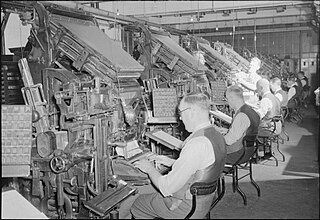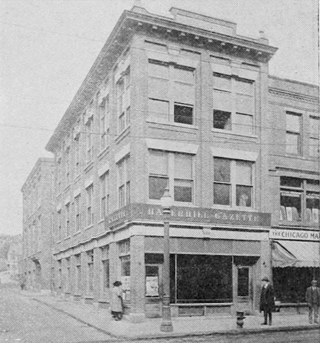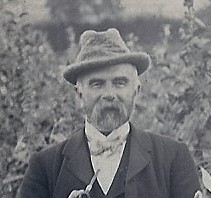
The history of British newspapers dates to the 17th century with the emergence of regular publications covering news and gossip. The relaxation of government censorship in the late 17th century led to a rise in publications, which in turn led to an increase in regulation throughout the 18th century. The Times began publication in 1785 and became the leading newspaper of the early 19th century, before the lifting of taxes on newspapers and technological innovations led to a boom in newspaper publishing in the late 19th century. Mass education and increasing affluence led to new papers such as the Daily Mail emerging at the end of the 19th century, aimed at lower middle-class readers.

The New York Herald was a large-distribution newspaper based in New York City that existed between 1835 and 1924. At that point it was acquired by its smaller rival the New-York Tribune to form the New York Herald Tribune.

The Manchester Evening News (MEN) is a regional daily newspaper covering Greater Manchester in North West England, founded in 1868. It is published Monday–Saturday; a Sunday edition, the MEN on Sunday, was launched in February 2019. The newspaper is owned by Reach plc ,[2] one of Britain's largest newspaper publishing groups.

The Richmond Times-Dispatch is the primary daily newspaper in Richmond, the capital of Virginia, and the primary newspaper of record for the state of Virginia.

The Standard-Times, based in New Bedford, Massachusetts, is the largest of three daily newspapers covering the South Coast of Massachusetts, along with The Herald News of Fall River and Taunton Daily Gazette of Taunton, Massachusetts.

The Northern Star and Leeds General Advertiser was a chartist newspaper published in Britain between 1837 and 1852, and best known for advancing the reform issues articulated by proprietor Feargus O'Connor.

The Evening News, earlier styled as The Evening News, and from 1889 to 1894 The Evening News and Post, was an evening newspaper published in London from 1881 to 1980, reappearing briefly in 1987. It became highly popular under the control of the Harmsworth brothers. For a long time it maintained the largest daily sale of any evening newspaper in London. After financial struggles and falling sales, it was eventually merged with its long-time rival the Evening Standard in 1980. The newspaper was revived for an eight-month period in 1987.

The Register, originally the South Australian Gazette and Colonial Register, and later South Australian Register, was South Australia's first newspaper. It was first published in London in June 1836, moved to Adelaide in 1837, and folded into The Advertiser almost a century later in February 1931.

The Cambrian News is a weekly newspaper distributed in Wales. It was founded in 1860 and is based in Cefn Llan Science Park, Aberystwyth. Cambrian News Ltd was bought by media entrepreneur Sir Ray Tindle in 1998.

The Chicago Daily Journal was a Chicago newspaper that published from 1844 to 1929.
Wednesday Journal, Inc. is a newspaper publisher based in Oak Park, Illinois. It publishes a free weekly community newspaper in Chicago's Austin neighborhood, paid weekly newspapers in the city's western suburbs and parenting magazines in the Chicago metropolitan area.

The Haverhill Gazette is a weekly newspaper in Haverhill, Massachusetts, owned by Community Newspaper Holdings Inc. of Montgomery, Alabama. For at least part of its history, it was a daily. In 1998 the paper was bought by the Eagle Tribune Company and converted to a weekly. In 2005 it was bought by Community Newspaper Holdings. The publisher is John Celestino, who oversees the Haverhill Gazette and its sister papers in the North of Boston Media Group.
The St James's Gazette was a London evening newspaper published from 1880 to 1905. It was founded by the Conservative Henry Hucks Gibbs, later Baron Aldenham, a director of the Bank of England 1853–1901 and its governor 1875–1877; the paper's first editor was Frederick Greenwood, previously the editor of the Conservative-leaning Pall Mall Gazette.

John Proctor was a British artist, cartoonist and illustrator, well known in his day for political cartoons in magazines such as Judy and Moonshine, rivals to Punch. He also illustrated many books and was one of Lewis Carroll's choices to illustrate Alice Through the Looking-Glass instead of John Tenniel.

James Henderson was a British newspaper and magazine proprietor and publisher, who was influential in developing the popular press and comics in Britain. He established James Henderson & Sons Ltd, which published many newspapers and magazines as well as books and postcards.
The Manchester Journal is a weekly newspaper in Manchester, Vermont. The paper, founded by Charles A. Pierce, published its first issue on May 28, 1861. According to the American Newspapers Representative database, the Manchester Journal has a weekly circulation of 7,088 and is distributed every Friday.
Shurey's Illustrated was a one penny weekly illustrated newspaper launched during the Second Anglo-Boer War. While other illustrated papers launched at the time, such as The Illustrated War News, focused on the war, Shurey's Illustrated also covered other topics, including sports and social events. It was one of a stable of one-penny weekly illustrated papers managed by Charles and Henry Shurey.
Funny Folks was a British periodical published between 1874 and 1894. It was published in London by Scottish newspaper proprietor James Henderson. It has been called "the first English 'comic' paper", and "the model for all later British comics".
C. Arthur Pearson Ltd was a British publisher of newspapers, periodicals, books, and comics that operated from 1890 to c. 1965. The company was founded by C. Arthur Pearson, later to be known as Sir Arthur Pearson, 1st Baronet.













